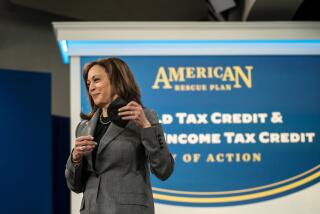A Return to Rational Rates
- Share via
Which of the following statements sounds right?
A) If I risk my money in a productive business venture, I deserve whatever reward that venture brings.
B) If I risk my money in a productive business venture, the government deserves a chunk of any reward that I get.
President Bush, in asking Tuesday that Congress cut the tax rate on long-term capital gains to 15.4%, is merely restating what is obvious to anyone who ever invested a dollar: If you take a chance, you should be able to keep your winnings--or most of them, anyway.
If Congress goes along with such a tax break, it will hardly be sailing the Ship of State into uncharted waters. On the contrary, all Bush seeks to do is restore a key feature of the tax system that served the nation pretty darn well for most of the modern age.
As the accompanying chart shows, investment capital gains received preferential tax treatment continuously from the end of World War II until 1986. Then, in a well-intentioned but fatally flawed tax-reform experiment, Congress decided to tax all income at the same rates, now a 28% maximum. That meant that a capital gain--the rise in the value of an investment--was taxed the same as wages, interest or dividends.
Until 1986, there had been general (though certainly not unanimous) agreement in the nation that investors should be given an incentive to commit their funds to long-term investments such as stocks. Or at the very least, there was agreement that investors should be penalized less, through taxes, for taking such risks than for simply leaving their money in a safe bank account.
Investment, after all, is what builds the economy. Bankers are good at lending to big firms, but investing in small businesses isn’t banks’ forte.
How much a capital gains tax advantage actually fosters investment isn’t known and never will be known--it can’t be quantified to anyone’s satisfaction. But it’s interesting to chart the progress of the stock market since World War II against changes in the capital gains tax rate:
* In the 1950s and 1960s, the top federal tax rate on so-called ordinary income, such as wages, remained high--mostly in the 70% to 87% range. So Uncle Sam took 70 cents to 87 cents of every $1 you earned above a certain income level.
But the top capital gains tax rate in those decades was 25%. So if you invested in stocks, for example, and they soared in value, you knew that Uncle Sam would never take more than 25 cents on every $1 of profit you earned. Clearly, there was a tax incentive to invest.
Perhaps it was purely coincidental, but the stock market rose steadily and dramatically throughout most of the 1950s and 1960s.
* In the 1970s, the top tax on ordinary income stayed at 70%, but from 1972 to 1978 a revenue-hungry U.S. government boosted the top tax on capital gains to 49.2%. Though there was still a tax advantage to investing, it was less enticing.
Again, perhaps just coincidentally, the stock market was a dud in the 1970s: Stocks rose at a slower pace than at any time since the 1930s.
* With the arrival of Ronald Reagan in the White House in 1980, a new tax revolution began. The top tax on wages fell to 50%, and the top capital gains rate plunged to 20%, even below the 25% rate of the 1950s. In 1982, the greatest bull stock market in history was born.
That bull market then ended, or at least paused for a long while, starting in 1987--just as the government tossed out the tax break for capital gains and instead declared that investment dollars earned were no different than wages earned.
Stephen Roach, economist for Morgan Stanley & Co. in New York, recalls the 1986 tax act as “one of those experiments that seemed like it was concocted in a laboratory.” And that’s not a compliment.
Forget, for a moment, the debate over how to replace the tax revenues temporarily lost with a capital gains tax cut; forget the debate over who gets most of the benefits (the rich or the middle class). Doesn’t it simply make sense that, in a capitalistic society, people who take long-term risks to fund businesses via stocks or other securities should be allowed to keep their winnings, or the lion’s share of them?
Shouldn’t you be better rewarded for investing in a start-up company that hires people and makes things than for merely leaving your cash in a risk-free savings account at the bank?
If you don’t think so--well, sorry, but Marx and Lenin are dead, literally and figuratively.
Roach, who testified before Congress in December on tax issues, believes that the new Washington wisdom toward capital gains isn’t just coming from the White House. A capital gains tax cut would benefit all investments, not just stocks. But stocks usually are the vehicle on which the debate is focused. And Roach believes that many in Congress finally understand that the money-raising function of the market is key to the long-term success of American companies, which face a mounting challenge from overseas competitors.
“I sense a transformation in Congress,” Roach says. “I think they’ve got a longer-term strategic focus for the nation than I’ve seen in a long time.”
If that’s true, and a capital gains tax break is restored, the irony will be that so many individual investors saw the future well before Congress did: Much of the money that has fueled the stock market over the past year has come from average individuals who have shifted dramatically from the consumption mania of the 1980s to a savings and investment mind-set for the 1990s.
“Individual investors are speaking with their dollars,” says Michael Hines, senior vice president of marketing at mutual fund giant Fidelity Investments in Boston. They already see the wisdom of investing in America--for its own good, and for theirs. By restoring the capital gains tax break, Congress can only encourage a lot more of that.
Capital Gains Tax: A History:
From World War II until the late 1980s, the government always taxed capital gains at a lower rate than ordinary income (such as wages). Tax reforms that began in 1986 eliminated the benefits for capital gains--which President Bush now wants to restore.
1991: 28%
More to Read
Inside the business of entertainment
The Wide Shot brings you news, analysis and insights on everything from streaming wars to production — and what it all means for the future.
You may occasionally receive promotional content from the Los Angeles Times.










